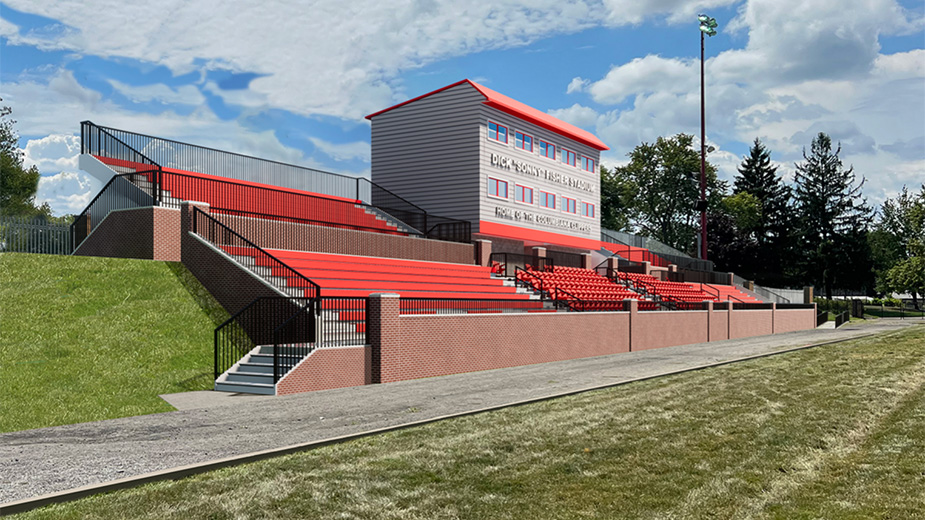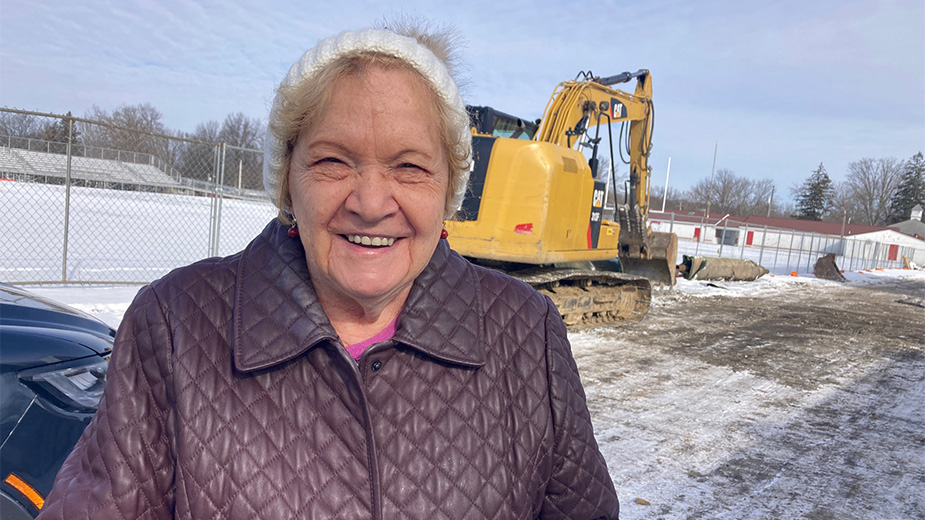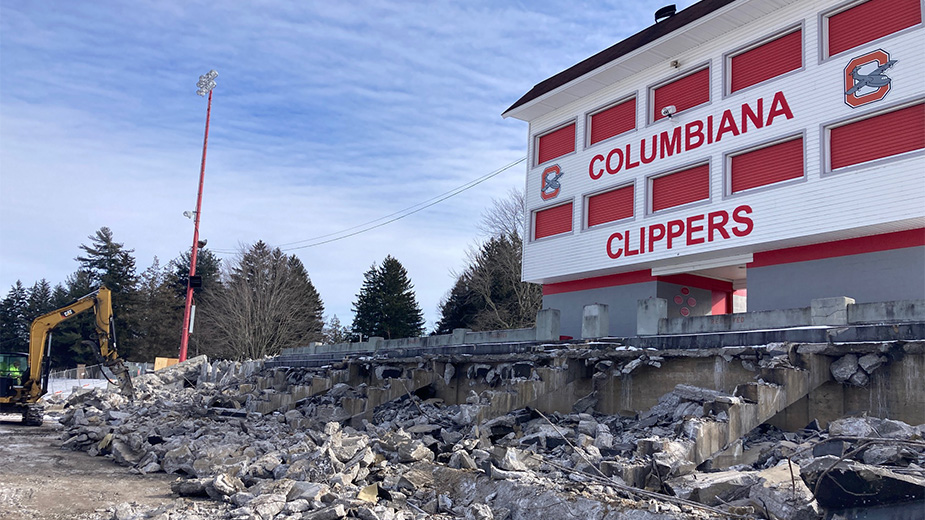Work Begins to Replace Columbiana Football Stadium
COLUMBIANA, Ohio – Football fans who go to Columbiana High School home games will have a new and more comfortable seating area when the upcoming season begins.
Demolition of the old stands began Tuesday, kicking off the $1.4 million first phase of the stadium’s reconstruction.
The stadium was built in 1936 in Firestone Park. It’s one of a scant few high school football stadiums nationwide that is in a municipal park instead of on campus.
The first phase of the reconstruction entails rebuilding the seating area and will be complete by August. Less Contracting Co. of Salem began jackhammering the concrete Monday.
The new stands, to be built by Jim Santini Builders of Washingtonville, will seat 980 – just shy of the previous capacity of 1,000, according to Sean Zentner, president of the Columbiana Athletic Boosters.
The central section will be reserved seating and will feature comfortable chairback seats. The remainder of the new seating area will have aluminum bleacher seats, with two wings of elevated seats extending along the sides of the press box structure. The press box will remain intact but undergo upgrades.

The new seating area will rest on a concrete foundation, as it always has. The sides and front walls will be made of decorative red bricks.
After completion of the current work, two more phases will follow.
Phase 2 will entail replacing the playing surface, possibly with artificial turf; resurfacing the track that surrounds the field; and installing fencing and drainage infrastructure.
In Phase 3, the locker and weight rooms will be remodeled; the existing concession stands will be converted to restrooms and a new concession stand will be built; a band shell will be built; and lights, sound equipment, the scoreboard and advertising signage will be replaced.
A fundraising effort is underway to fund the second and third phases. When complete, the total cost of the stadium renovation will be $3.2 million. To donate, email boosters@columbianaschools.org or call 330 518 7170.
Funding for the Stadium
The lion’s share of funding for the first phase came from Pat Tingle, the Columbiana resident and philanthropist who has already given millions of dollars for the makeover of Firestone Park.
Tingle has contributed more than $1 million for the stadium’s first phase, with the Columbiana Athletic Boosters raising about $300,000 from community residents and businesses.
“For the last 10 years, this has been my life’s work,” said Tingle, referring to the transformation of Firestone Park.
The park was donated to the city in the 1930s by Harvey S. Firestone, founder of the tire company that bears his name and a native of Columbiana.

Tingle and her late husband, Bradley, grew up in Columbiana, and she feels a strong connection to the park.
But the stadium also has a strong emotional pull for her. Once reopened, it will be known as Dick “Sonny” Fisher Stadium in honor of one of the greatest athletes to come from Columbiana.
Fisher was also Tingle’s uncle.
When he was at Columbiana High School, he set many school football records. He attended The Ohio State University from 1939-1941, where he was an All-American football and basketball player. That’s also where he earned the nickname “The Columbiana Clipper,” which an announcer called him because of his speed.
The nickname was later adapted by Columbiana High as the name of its sports teams.
Tingle is considering having an artist paint a portrait of Fisher on the wall of the press box that will be visible to all as they enter the stadium.
Looking ahead to the second and third phases of the stadium reconstruction project, discussion has begun over whether to replace the playing surface with artificial turf or simply improve the existing grass field and its drainage system.
Tingle prefers grass, as it would maintain the aesthetics of the park that surrounds it.
Skip McCulllough, who is a trustee of the park beautification committee and a member of the stadium committee, also prefers grass, citing statistics that show there are more injuries on artificial turf.
He has proposed contacting local school districts that have installed artificial turf to learn about their experiences.
Stadium’s Design
The new stadium has been designed to aesthetically complement the park and honor its legacy, said Summer Barker of Strollo Architects of Youngstown.
Barker was at the stadium Wednesday, watching the demolition.
“We are removing a big piece of history that sits in the middle of the park, and we want to honor it,” she said of the design.
Gregg Strollo, president of Strollo Architects, pointed out the stadium was built by the Works Progress Administration, a Depression-era program that employed workers to build large municipal structures.
Zentner of the Columbiana boosters is excited for the new stadium, which he said is a necessity.
“We can’t wait until it’s done,” he said. “I played football here, and my kids played here. It’s been needed, and it’s finally coming to fruition.”
Jason Freed, a 1998 graduate of Columbiana High School where he played on the football team, understands the importance of the stadium and the sports program.
“That field holds a million memories for me,” said Freed. “I honestly went from a boy to a man during two-a-days on the practice field under coach [Bob] Spaite. He was like a second father to me and many other kids. High school football can be instrumental in shaping boys’ futures. It teaches you teamwork, discipline and responsibility. It also gives kids opportunities through college scholarships that they wouldn’t have had otherwise.”
Pictured at top: Demolition of the Columbiana football stadium began Wednesday.
Copyright 2024 The Business Journal, Youngstown, Ohio.



